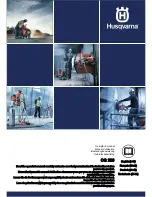
9
Then rotate the wheel guard to such an angle that it can
protect the operator according to work. Be sure to tighten
the screw securely.
To remove wheel guard, follow the installation procedure
in reverse.
For tool with clamp lever type wheel guard (Fig. 6 & 7)
Loosen the lever on the wheel guard. Mount the wheel
guard with the protrusion on the wheel guard band aligned
with the notch on the bearing box. Then rotate the wheel
guard around to the position shown in the figure. Tighten
the lever to fasten the wheel guard. If the lever is too tight
or too loose to fasten the wheel guard, loosen or tighten
the nut by spanner to adjust the tightening of the wheel
guard band.
To remove wheel guard, follow the installation procedure
in reverse.
Installing or removing depressed center
grinding wheel/Multi-disc (optional
accessory) (Fig. 8)
Mount the inner flange onto the spindle. Fit the wheel/disc
on the inner flange and screw the lock nut onto the
spindle.
To tighten the lock nut, press the shaft lock firmly so that
the spindle cannot revolve, then use the lock nut wrench
and securely tighten clockwise.
(Fig. 9)
To remove the wheel, follow the installation procedure in
reverse.
WARNING:
• Never use a more than 6.5 mm thick grinding wheel.
Super flange
Models with the letter F are standard-equipped with a
super flange. Only 1/3 of efforts needed to undo lock nut,
compared with conventional type.
Installing or removing abrasive disc
(optional accessory)
NOTE:
• Use sander accessories specified in this manual.
These must be purchased separately.
(Fig. 10)
Mount the rubber pad onto the spindle. Fit the disc on the
rubber pad and screw the lock nut onto the spindle. To
tighten the lock nut, press the shaft lock firmly so that the
spindle cannot revolve, then use the lock nut wrench and
securely tighten clockwise.
To remove the disc, follow the installation procedure in
reverse.
OPERATION
WARNING:
• It should never be necessary to force the tool. The
weight of the tool applies adequate pressure. Forcing
and excessive pressure could cause dangerous wheel
breakage.
• ALWAYS replace wheel if tool is dropped while
grinding.
• NEVER bang or hit grinding disc or wheel onto work.
• Avoid bouncing and snagging the wheel, especially
when working corners, sharp edges etc. This can
cause loss of control and kickback.
• NEVER use tool with wood cutting blades and other
sawblades. Such blades when used on a grinder
frequently kick and cause loss of control leading to
personal injury.
CAUTION:
• Never switch on the tool when it is in contact with the
workpiece, it may cause an injury to operator.
• Always wear safety goggles or a face shield during
operation.
• After operation, always switch off the tool and wait until
the wheel has come to a complete stop before putting
the tool down.
Grinding and sanding operation
ALWAYS hold the tool firmly with one hand on rear handle
and the other on the side handle. Turn the tool on and
then apply the wheel or disc to the workpiece.
In general, keep the edge of the wheel or disc at an angle
of about 15 degrees to the workpiece surface.
During the break-in period with a new wheel, do not work
the grinder in the B direction or it will cut into the
workpiece. Once the edge of the wheel has been rounded
off by use, the wheel may be worked in both A and B
direction.
(Fig. 11)
Operation with wire cup brush (optional
accessory)
CAUTION:
• Check operation of brush by running tool with no load,
insuring that no one is in front of or in line with brush.
• Do not use brush that is damaged, or which is out of
balance. Use of damaged brush could increase
potential for injury from contact with broken brush
wires.
(Fig. 12)
Unplug tool and place it upside down allowing easy
access to spindle. Remove any accessories on spindle.
Mount wire cup brush onto spindle and tighten with
supplied wrench. When using brush, avoid applying too
much pressure which causes over bending of wires,
leading to premature breakage.
Operation with wire wheel brush (optional
accessory)
CAUTION:
• Check operation of wire wheel brush by running tool
with no load, insuring that no one is in front of or in line
with the wire wheel brush.
• Do not use wire wheel brush that is damaged, or which
is out of balance. Use of damaged wire wheel brush
could increase potential for injury from contact with
broken wires.
• ALWAYS use guard with wire wheel brushes, assuring
diameter of wheel fits inside guard. Wheel can shatter
during use and guard helps to reduce chances of
personal injury.
(Fig. 13)
Unplug tool and place it upside down allowing easy
access to spindle. Remove any accessories on spindle.
Thread wire wheel brush onto spindle and tighten with the
wrenches.
When using wire wheel brush, avoid applying too much
pressure which causes over bending of wires, leading to
premature breakage.










































